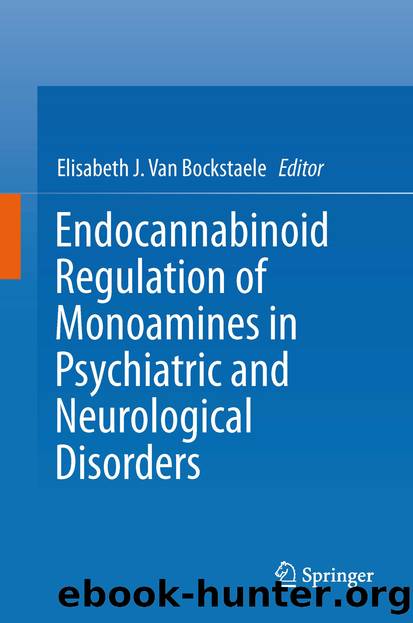Endocannabinoid Regulation of Monoamines in Psychiatric and Neurological Disorders by Elisabeth J. Van Bockstaele

Author:Elisabeth J. Van Bockstaele
Language: eng
Format: epub
Publisher: Springer New York, New York, NY
8.5 Influence of Gender
The prevalence of depression is greater in women than men, at a ratio of approximately two to one (Kuehner 2003; Piccinelli and Wilkinson 2000; Lundberg 2005). The specific causes of this disparity are currently unknown, although evidence suggests both biological and social factors play key roles. Biologically, developmental effects of sex as well as of gonadal hormones have a strong influence on the functioning of monoamine systems, including the noradrenergic system. There are also reciprocal interactions between gonadal hormones and the endocannabinoid system. Finally, there is evidence suggesting sex differences in response to stress, with a potentially increased vulnerability to stress-related disorders in women.
Sex differences have been shown in some animal models linking stress and depression (Dalla et al. 2010). In those models, females appear more vulnerable to developing depression-like behaviors. Female rats exhibit greater levels of immobility in the FST (Dalla et al. 2008a; Drossopoulou et al. 2004; Pitychoutis et al. 2009) and show greater vulnerability to swim stress compared with males (Sun and Alkon 2006). FST also leads to an increased hippocampal and hypothalamic serotonergic signaling in male rats but decreased signaling in female rats (Drossopoulou et al. 2004), while only males display reduced levels of glucocorticoid receptor mRNA in the hippocampus following repeated exposure to swim stress (Karandrea et al. 2002). In addition, in measures of associative learning following shock or swim stress, a model of cognitive deficits that can occur in depression, females exhibited impairment, whereas males show enhanced learning (Shors et al. 2007); this is associated with decreased density of dendritic spines in the CA1 area of the hippocampus of females, but increased density in males, following stress exposure (Shors et al. 2001, 2007). Chronic mild stress has been shown to produce a greater increase in basal levels of corticosterone and to disrupt hippocampal serotonergic and prefrontal dopaminergic activity more readily in females (Dalla et al. 2005). However, chronic mild stress also appears to produce a less consistent reduction in sucrose water consumption, a measure of anhedonia, in females (Dalla et al. 2005, 2008a); this may be because females naturally exhibit less consistent patterns of sucrose consumption even in the absence of stress (Dalla et al. 2008a).
In other models however, males seem to be more vulnerable than females. In contrast to shock or swim stress and associative learning, male rats exhibited impaired spatial learning in the Y-maze following acute restraint stress (Conrad et al. 2004) and in the Morris water maze after chronic restraint stress (Bowman et al. 2003; Kitraki et al. 2004). In contrast to males, females exhibited enhanced spatial learning following restraint stress . In the learned helplessness model, which has been viewed as “hopelessness” in depression , male rats more readily develop learned helplessness and decreases in neurogenesis in the dentate gyrus following exposure to repeated inescapable foot shocks, while sexual dimorphism in the alteration of monoamine activity was also seen (Shors et al. 2007; Heinsbroek et al. 1991). Some of the above-mentioned differences, such as in associative learning
Download
This site does not store any files on its server. We only index and link to content provided by other sites. Please contact the content providers to delete copyright contents if any and email us, we'll remove relevant links or contents immediately.
When Breath Becomes Air by Paul Kalanithi(7264)
Why We Sleep: Unlocking the Power of Sleep and Dreams by Matthew Walker(5642)
Paper Towns by Green John(4169)
The Immortal Life of Henrietta Lacks by Rebecca Skloot(3826)
The Sports Rules Book by Human Kinetics(3588)
Dynamic Alignment Through Imagery by Eric Franklin(3489)
ACSM's Complete Guide to Fitness & Health by ACSM(3469)
Kaplan MCAT Organic Chemistry Review: Created for MCAT 2015 (Kaplan Test Prep) by Kaplan(3423)
Introduction to Kinesiology by Shirl J. Hoffman(3301)
Livewired by David Eagleman(3123)
The River of Consciousness by Oliver Sacks(2992)
Alchemy and Alchemists by C. J. S. Thompson(2912)
The Death of the Heart by Elizabeth Bowen(2901)
Descartes' Error by Antonio Damasio(2731)
Bad Pharma by Ben Goldacre(2730)
Kaplan MCAT Behavioral Sciences Review: Created for MCAT 2015 (Kaplan Test Prep) by Kaplan(2492)
The Gene: An Intimate History by Siddhartha Mukherjee(2491)
The Fate of Rome: Climate, Disease, and the End of an Empire (The Princeton History of the Ancient World) by Kyle Harper(2436)
The Emperor of All Maladies: A Biography of Cancer by Siddhartha Mukherjee(2431)
